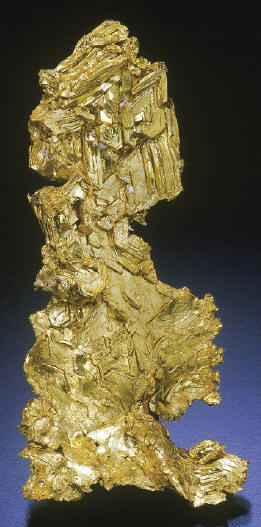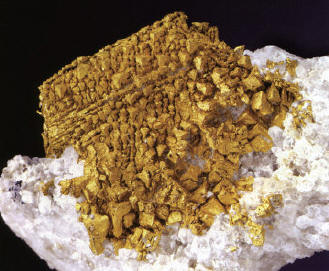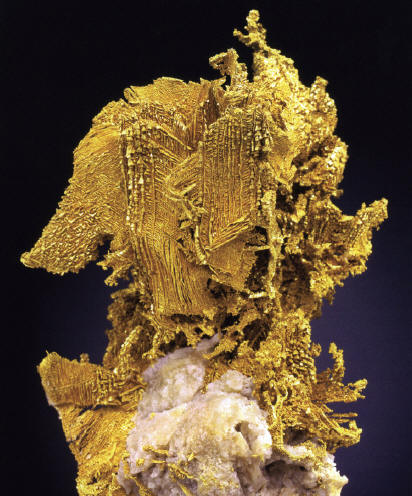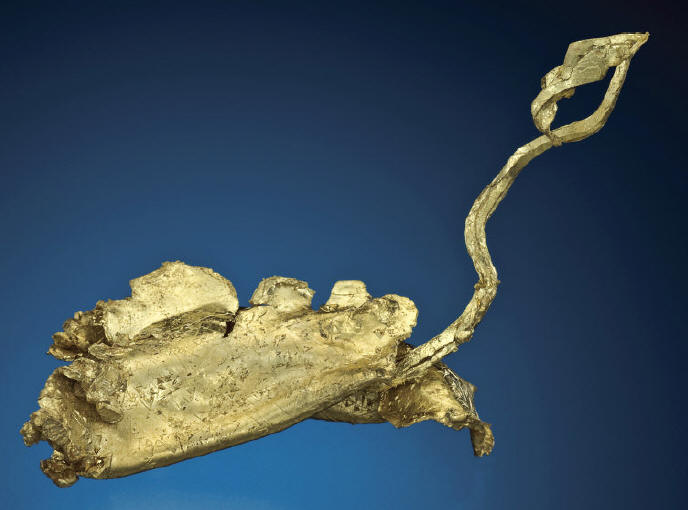Author: R. ScottWERSCHKY Date: 2014-9-24 19:08:25

Exceptionally large octahedral spinel lawtwins forming lustrous leaf. Size 6.7 cm.K&M Proctor coll. J. Scovil photo.
While gold is the principal ore mineralof the deposit, trace amounts of nativesilver as well as silver sulfosalts,sulfides, and tellurides have been encounteredsuch as mckinstryite, stromeyerite,and pyrargyrite. Unfortunately,no published data is yet availabledetailing this mineralogy.
Gold in the Round Mountain depositis silver-rich. The average gold specimenfrom Round Mountain is 63.5% gold and37.5% silver. This ratio appears tobe consistent throughout the deposit.
Amazingly, there is no vertical zonationor variations in the silver content at themine. This is highly unusual for epithermalgold systems. Additionally, geologistsat the mine say that there is lessthan 2% difference in the silver contentabove the water table where oxidationcan preferentially leach out silver fromthe rock.
GOLD MORPHOLOGY
A key feature of the Round Mountainmine is the great diversity of goldhabits and styles. The early specimenswere massive and/or leafy in nature, andwere not particularly interesting to mineralcollectors. In fact, there were greatdifficulties selling golds from RoundMountain in the early years. The goldwas not crystalline enough for collectors,and not rounded enough or yellowenough to interest the nugget collectingmarket. In 2001, the first fine crystalswere encountered, and several differenthabits are noteworthy. While there aremany different habits of gold in the deposit,Round Mountain gold does have anoverall look that is quite distinctive.
Select pieces can resemble golds fromBreckenridge (Colorado, USA), Verespatak(Romania), Eagles Nest (California,USA), and even Liberty (Washington,USA). However, the combinationof form and color is readily recognizableto one familiar with gold specimens.Following is a brief summary of the goldstyles from Round Mountain.
Massive gold
The massive gold is texturally unremarkableas expected from the classification.Large masses have been found tomore than 6 kg. These masses are typicallyless than 3 cm thick, but are knownto reach sizes to 20 cm long and 8 cmthick. The masses mimic the shapes ofveins which are typically less than 10 cmin width.
Wire gold
Wire gold is rarely seen at RoundMountain. In fact, only a handful of specimenswith well formed wires are known.This is to be expected, as wires are therarest form of gold in nature. The wirescan be striated, and are arcuate totightly curved or coiled. They occur bothas isolated single strands and densemasses with hundreds of tiny wires. Allof the specimens seen to date are small(less than 8 cm). Most of the individualwires are less than 2 mm thick and <1to 2 cm long, although one wire was morethan 40 mm long by 3 mm thick.
Ribbon gold
Ribbon gold at Round Mountain occursas thin leaves less than 1 mm thick,2 or 3 mm wide, and 5 to 20 mm long. Thespecimens form in groups of hundreds ofthe ribbons tightly packed just like thewire gold. The ribbons vary from flat andstraight to tightly curved or curly. Only afew such pieces have been identified todate. Ribbon gold can be considered intermediatebetween wire and leaf gold.
Leaf gold
The most common form of gold inthe Round Mountain deposit is leaf gold.Leaves can be very tiny to quite large.Fine specimens with leaves to 15x5 cmhave been found. The leaves are typicallyvery thin and are often delicate like foil.

Cubic spinel twins on an cubooctahedral spinel twin! Size 5 cm. K&M Proctor specimen. J. Scovil photo.

Spinel law twinned crystals of gold. Size 5.7 cm. Miner’s Lunchbox specimen now in K&M Proctor coll. J. Scovil photo.

One of the finest golds from Round Mountain. Textbook example of cubic crystal spinel law twinning on herringbone leaves. Size 11 cm. Miner’s Lunchbox specimen now in P. Weiss coll. J. Scovil photo.
Stout leaves thicker than 1 or 2 mm are the exception. Although leaf gold isactually crystalline, the leaves do not alwayshave nice crystal faces at the mar-gins. Certainly, the best leaf specimenshave beautiful octahedral or cuboctahedralcrystals (typically flattened) at theedges. Leaf gold can vary from a dull,matte finish to extremely lustrous gold. The best pieces exhibit almost mirrorlike luster.

One of the best known gold wires from Round Mountain. Size 5.9 cm. Miner’s Lunchbox Specimen. J. Scovil photo.







 YueGongAnBei 44051102000467
YueGongAnBei 44051102000467


 |
|